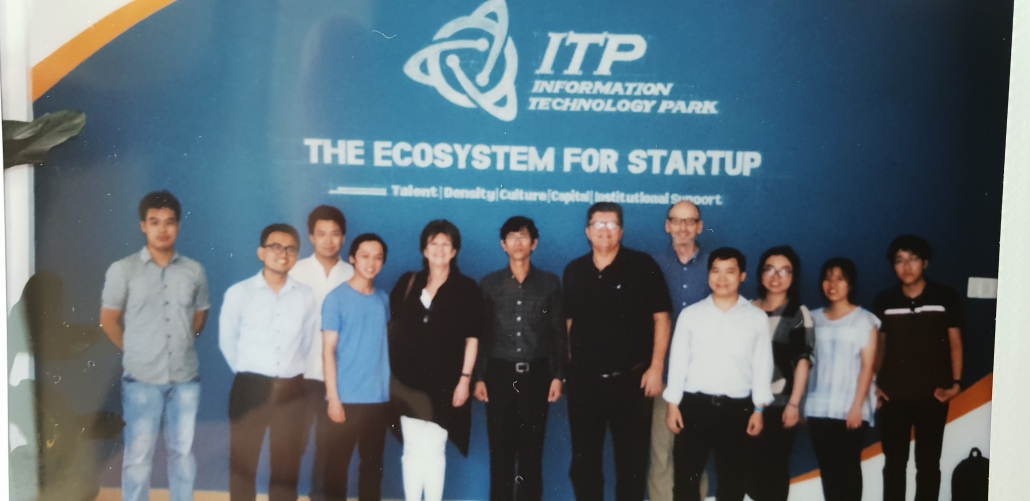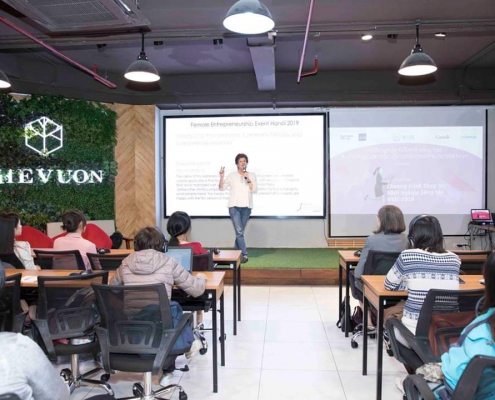Two hundred years ago, Europe was the dominant innovation hotspot in the world. Machines, automobiles, trains, airplanes, architecture innovation… almost everything came from Europe. That changed about 60 years ago.
Innovation shift to the US, then China
John F. Kennedy gave the change signal. “We take a man to the moon and bring him safely back by the end of the decade.” The United States had a vision bigger than life. In the ’80s, the democratization of computing power was yet another significant shift. The Internet in the mid-’90s, Social Media around 2005, and everything digital in the early 2010s. Apple, Intel, Microsoft, Visa, MasterCard, Cisco, Oracle, Google, Netflix, Salesforce, Paypal, LinkedIn, Facebook, Uber, Tesla, YouTube, AirBnB, Space-X, Stripe, Y-Combinator, 23andMe, GenTech… The digital world – the technology for our future – is now driven by US firms. SAP, founded in April 1972, was the last European innovator that made it to a global leader.
In the early 2000s, another innovation driver was rising: Asia. Mainly China, Singapore, and South Korea became not just fast producers, efficient builders and inexpensive labor but full of innovative minds. While dealers and retailers in Europe had been arguing about Amazon’s disruptive power, there was nobody who tried to compete. Zalando in Germany stood up, but instead of triumph and support, they have been beaten down for all kinds of nitty-gritty details. Eventually, Alibaba of China attacked Amazon at their own game. Today super successful with a new and disruptive business model. Another notable Chinese company, Tencent, grew out of nothing as a rising star. A tech company that sees opportunities and fulfills them. TikTok, for instance, a Tencent company, is growing faster in the video space than any other company ever did. Megvii, a powerful AI company, Baidu, Ecovacs Robotics, Huawei, BOE, ByteDance, Byton (EVs), Geeli (EVs), Pony.AI, UCloud, Xiaomi, and so forth. Most of them have not been noticed in Europe. The market size, with a population of 3.8 Billion in Asian plus 1.4 Billion in Africa is so much more attractive and more open to innovation than the European market with a population of just 500 Million.
What’s the problem in Europe
Schools are great. People are smart, hard-working, intelligent, creative, innovative thinkers, good business people, good engineers and good scientists. Europeans practice a “problem solver” culture, can collaborate very well, have centuries of innovation history and build some of the finest products. They seem to be the top predator in the global economy. Yet zero notable innovation. Europeans can’t get traction, scale, growth and eventually get bypassed by foreign competition. What’s wrong with the old continent? Top people who would have left for Silicon Valley 10 years ago can now be found in Shenzhen, Singapore, Seoul, and many other cities. Byton, a fast-growing electric car company – a real competition to Tesla by the way – is not only one of many Chinese car manufacturers – its a German startup in China. Former BMW managers started Byton. Within three years, they designed, tested, produce a complete, fully electric car and built the manufacturing plant – all at the same time. Impossible to do that in Germany.
Regulated to death
Regulations, administration, bureaucracy and security thinking is one thing; labor costs another item, space yet another one. But all that is not the real bummer – and no – not even capital as most would immediately point out. It is a terrible cultural development from the past 50 years. Europeans have a protectionist and safety-oriented mindset like no other society on earth. Insurances, social security, data privacy and numerous other topics literally dominate European culture. Whether you look at Sweden, Germany, Switzerland, France, Spain, Hungary, or any other country, companies who innovate and disrupt get banned – preservers are in power. Uber is banned in most Swiss cantons. Amazon can’t do business in Switzerland directly. AirBnB, Paypal, and many others have a hard time to get “approved”. And it’s not just US or Chinese companies. Even European innovators have the most challenging time in their home mainland. IKEA wanted to open a shop in Nice/France – it endures forever. And on and on it goes. The protection of the dying local shops is more important than innovation. Why? Because the local shop lobby is bigger and connection to community authority stronger than the interest in standing up and competing. And in Europe, protecting means avoidance of change. Autonomous cars can’t be tested because it is considered not safe enough. Well, then all European car maker march one more time to Silicon Valley, let their cars test there and – ooops also the entire experience moves there. Most car manufacturers hold a potent board – but no experience in the digital world. As a result: some 100 LEDs are the innovation of the day. Few have experience with modern business models. As a result: Accessory manufacturers dictate pricing structures that create a car’s configuration merely a joke – but nobody is noticing. Those add ons are as old as it can be. But European car manufacturers don’t even know what their customers want; “Vive la GDPR”
Privacy protection and innovation
What has one to do with the other? Again nobody notices. Every innovative idea ever created comes from the brain. Our neurons compose new ideas from past experiences. If you never had any experience with Lexicrypt, you won’t be able to innovate around Lexicrypt. And if you don’t know what your customers really want – you cannot innovate for them. The Vendor-Customer communication is so isolated from each other, it’s stronger than an iron curtain – more potent than the Berlin Wall – more protected than China from Facebook, harder to crack than any business secret from the closest competitor. Whoever suggested this massive data protection mechanism to the European Commission did the perfect job that even the best spy movie author could not come up No cyberwar author could have done a better job than that: Eliminate an entire continent by cutting their communication off and making them do it themselves. And the security play was so easy in the most fearful culture on earth.
Lack of courage
Moreover, in most European countries, top US consulting companies run governments, military, corporations, leading universities – everything. Why? because somebody needs to take the risk of making a mistake. “We spend billions in the best consulting firms; they confirmed that it’s a great job. I’m not guilty”. COURAGE has become an unknown word in Europe’s C-Level, University leaders, and military generals. If a nation is mostly busy protecting what they achieved and avoiding risks, they build a massive framework of rules and regulations. And if protection and regulation become the standard, courage is not a need. And even worse. Those who would have the courage get blocked by those who don’t and move on to nations where they can flourish. Europe’s brain drain is in full swing. And maybe the same is on the rise in the US. A problem that modern political systems have never faced and, therefore, no concept to even deal with it – let alone solve it. Even worse, it is not even seen as a challenge. What can be wrong with order? Order is good. Yes, and the requirement of order is no change, and that means banning innovation. There is no bad guy and nobody really guilty. We are living in a continuously evolving organism that simply could not see it coming. But today, we see that the tech world in Europe has nearly no way to catch up, the automobile world lost its edge and there is only a strategy to copy the new market leaders. Europe must crack this enormous nut. Innovate or get disrupted
Innovating the societal system
The list of nations that did not make it, is long: Egypt, the Roman Empire, British Empire and many in between. No society could ever escape that cycle. But no society has ever had such a deep understanding of human organization power, political systems, innovative behavior then we have today. Comparing it with a natural life and death cycle is not appropriate – no country actually died, the people stood alive, nothing broke – but the economy. And since we can fix smaller economic meltdowns, why not a big one? Maybe there is a chance to make a change; no society has ever been able to make “Disrupting itself”.
We are working with the BlueCallum team on structural innovation models that helps super enterprises, those with more than 25,000 employees, to change towards innovation. Maybe the collective intellect of the World Innovations Forum can help empowering nations. A good start could be working with jeopardized industries, like the Tourist industry hit hard by Covid19. Losing an old industry is not just making way for new industry players, it is also a loss of resources, experience, knowledge and more. I’m not talking about old and worthless knowledge but the ability to build knowledge, experience to find solutions and culture that cannot be transferred in another country but values that could help rebuild an innovative spirit that passed away.
 I’ve been asked so many times that I felt it would be good to write a blog post.
I’ve been asked so many times that I felt it would be good to write a blog post.
Obviously there are many consulting services, software developer and others who could built your MVP in a rather short period of time. Then you get what you asked for and can enter the market. If customers report bugs, you go back to your developer. And you hire them again and again – or you ignore the requests for now until you get more funding. It sounds totally logical. However reality tells a very different story:
Your MVP is a barebone minimum solution. It is supposed to be up rather quickly and your customers tell you what they experience, what they like and what they don’t like. If you have a CTO, it is not just taking the bug reports but carefully listening to each request. Each discussion with a customer contains a wealth of insights about how they use the product, what key benefits they have or want to have, how it is or should be integrated in other technologies and so forth. From that moment on you get probably daily requests for changes and more important lots of tiny little cool ideas that your developer or developer team can implement. I remember we received 1,400 feature requests, update requests and bugs within the first three month. You can’t pay your outsourcing organization to handle that.
Moreover our CTO saw what directions this will take and prepared the platform a bit differently. In the first six months, he was involved in almost any customer discussion. He needed to know and feel where this is going. More importantly he sensed functionalities based on the customer stories that led to functionalities they didn’t dear to ask but made a lot of sense and was no problem to do. The CTO is the one person who shapes the product, the future technology decisions and the technological direction of the company like nobody else. This cannot be outsourced – not at reasonable cost.
On top of all, the CTO does not try to build an MVP that meets the specification you gave them. The CTO is building the foundation of a solution that will change the world in the future and crafts an MVP that acts like the first cell of an organism.
Early Adopter Customer
If you have a sensational new application, you won’t get typical customers. Those ask you who else is using it, how many customers you have, are you funded and so forth. And so you have to look for early adopters. Thos premium customers are willing to check out new things because also they want to lead their market. BUt if you tell them that the technology was done by a freelancer, outsources, service organization or a like they get less motivated. They are taking a risk, dealing with a ne technology – but far less so when there is no CTO.
With all that said, there should be no reason to hire a consultant, rather than involving a top notch technologist.
Hire or Co-Founder?
first: as a startup you just cannot hire a top performing developer. No matter what you offer to pay. Therefore attract them as co-founder. Yes, they are hard to find and you want to start. But there is no shortcut what so ever. If that technology is a core element and differentiator of your business, than the person that builds it and develops it further over the next 10 years should have a seat on the founders bench.
As an investor
I would never invest in a company that outsources their development. It’s too clear that there is no technological focus or the technology doesn’t play any important role. It also shows that the founder could not attract any co-founder and I must ask: can they attract customers?
All in all the number of reasons for a co-founder CTO outweigh the short term benefit of getting a MVP slapped together for a demo.

Meeting with the ITP leadership team of the University of Ho Chi Minh City. An impressive presentation where Vietnam is planning to go what innovative businesses concerns. We also had some great meetings with students, who are very ambitious and eager to learn everything possible about innovative thinking and entrepreneurship.

Entrepreneurs Workshop with roughly 20 top startups and scaleups from Ho Chi Minh City. It was great fun to work with these super engaged and highly competitive teams. One of the things that all of them have in common with any top startup in the world: determination to win.

Investors meetings at the Kova facility. We discussed investor strategies, ways to select startups, due diligence processes and post investment mentoring. We also talked about the necessity to keep top companies in the country to not loose the innovative edge to somebody else.

A wonderful and very personal dinner at the Kova house. We enjoyed traditional Vietnamese food cooked by the lady of the house herself. This was an unforgettable evening.

Great discussions about innovative thinking, investment opportunities, ways to stimulate more innovation and getting startups better supported to be able to compete on a global scale. It was an amazing evening with amazing people.
HANOI

The future of innovation in Vietnam, Conference. Great and an amazing diverse speakers, high energy and very ambitious. We talked about the innovation paradigm and the value of going global for the national prosperity and wealth development.

We were invited by the University of Hanoi to speak about the Innovation Paradigm, the value creation for the national economy and what Vietnam can do to create an innovation economy within the country.

Interesting discussions about how to stimulate innovation and making innovation an even stronger point within an economy. Also we spoke about the value of speaking English as a prerequisite to participate in the global economy.

Meanwhile, Marita ran a workshop for female entrepreneurs. The interest to participate was so overwhelming that the initial 12 people roundtable had to be turned into a 70 attendee presentation and podiums discussion.

Full house at the female entrepreneurs meeting in Hanoi

A very interesting meeting at one of the largest mobile phone providers. The organization is determined to innovate and bring all new ideas to their customers. It is absolutely amazing to see how Vietnam turned from a rather poor country, dependent on donations, just three decades ago, into a vibrant emerging country.

An equally great meeting at one of the top business banks of Vietnam. Also here, business transformation, innovation and moving from an industry follower to an industry leader is an amazing transition. We talked about how innovative thinking is not just improving the status quo but how to get to an idealistic model and back to reality.

Today we may debate whether or not a robot will ever be superior to a human. Superiority has many angels. And a robot may not catch all of them. But in the basic work life, it is different. And maybe one robot may not be as good as a human – but a whole range of networked Artificial Intelligence-based robots will outperform us in almost any segment of work on all levels and all industries !!!
Our single biggest disadvantage
The vast majority of humans, still today, keep knowledge close to their chest. Sharing of knowledge, experience, and mistakes is not our biggest strength. Sitting in a corner, thinking through the permutations of what happens with a machine in certain circumstances – is our biggest strength. But we know that our brain capacity is not unlimited. As long as we continue to share only if really necessary, think for ourselves, hope we earn special attention for our knowledge – we are in danger that all our jobs get eradicated before we adapt to newer better behavior. Our physical limitations are too weak to stand up against a series of highly developed AI networked technology – whatever we call it.
Cultural Advancement
We are what we got introduced to by our cultural frameworks. Our parents teach us to be humble, not to share our experience unless it is necessary, to experiment for ourselves until we are sure that our experiments are successful. We are conditioned to not talk about things that are still uncertain. Our communication prison is huge. Some cultures however advanced already. And the most interesting thing is that it was actually that very advancement that brought the AI / Robotics technology to life – Silicon Valley. Now some may argue it was elsewhere and so and so already had developed that first version of AI years ago. Well – so sorry to say that, an innovation has absolutely no value unless it is brought to a broader market. “The initial value if any innovation is zero”. Without cultural advancement, we will maintain that widening gap between developed and emerging countries. As long as emerging countries do not embrace more openness, a culture where failure is not just OK but actually good and a key part of learning – the country will remain to be an emerging country.
Artificial Intelligence, biggest driver for human advancements
Humans have one extraordinary ability: humans can adapt to new situations within one and the same generation. No other life form can do that. Big Data is giving businesses who leverage big data a huge advantage over others because they simply know better and faster what is going on. If we learn that networked AI systems will be able to tap into those data and create analysis, able to make decisions and derive strategies from the results, They will be ahead of us and we will essentially do what they suggest. We can’t even verify in time so we simply go ahead and do it. Yes it’s still a tool – but we do what the tool is telling us what to do without even being able to debate it. But we will learn one thing: if we connect our brains we get a whole new edge – maybe beyond our own imagination.
Experiment at Society3 World Innovations Forum
Imagine we do what these AI networks do and network our brains, very simply on a daily base by sharing, communication, analyzing our own mistakes and come to new conclusions every day? The collective intellect when really in action has unknown and incomprehensible reserves. The least we can do is to explore them. And it is almost for free. We only have through some of the old cultural remains overboard. At Society3 this is exactly what is going on right now. Society3 is building a digital layer across the globe that exists to connect people and their ideas, challenges, questions and answers together. http://society3.com We are not here to win a competition with AI-based robots but simply bring human entrepreneurs to a level that has never seen before.
 In my previous two blog posts I shared a base view and two examples. In this post I will share some ways to get to a state of the art level of digitization in your business.
In my previous two blog posts I shared a base view and two examples. In this post I will share some ways to get to a state of the art level of digitization in your business.
As stated in the previous blog post, computerization or digitization 1.0 started in the 1960’s. With rare exceptions, most businesses are fully computerized. Computers, smartphones, Internet and the corresponding software are simply the underlying infrastructure for digitization. In my follow on blog post, Digitization is a mindset, I described the effects based on the two examples: Amazon and Uber.
Find out your degree of digitization
The degree of digitization today, can also be seen as a collection of individual and unique competitive advantages. If you like to further explore full digitization of your business you may want to use the following guidance:
- Think in degrees of digitization?
– Digitization is not a have or not have. It is a sliding scale from basic to medium, to good, to excellent
– Can you identify the degree of digitization in your business?
– Do you have a customer advisory board you can work with to increase the level of digitization? - Modern Business Culture?
– Digitization is a mindset and requires a modern, open minded and transparent company culture.
– Do you have an executive team or business owners who don’t want more transparency and rather keep everything close to their chest?
– Do you have an old style sales and marketing culture that prefers to deliver information only on request and see it as a special value rather than an obligation to freely provide it such as pricing etc. - What is your logistics integration look like
– Do you still need to manually enter orders, requests or anything else?
– Are your customer and business partners able to access any record of their transactions online?
– Can your customers see the order or return progress at any time online
– Can your customers access business history with you online?
– Are there any rewards systems for customer activities? - How deep is your sales channel all the way to the individual consumer integrated in your digital presence?
– Are your direct customers, business partners, vendors, supplier all the way to the individual end user of your products or services fully integrated in your digital presence?
– Can any of your customer access their own data easily in your system, maybe change their names, email addresses etc? Can they see the products they have and the services they can acquire?
– Do your customers have access to all the manuals, service descriptions, pricing, spare parts etc.?
– Do you have a customer community where your customers can meet and exchange experiences?
– Do you know if your final end consumer is interested in finding out more information from you?
– Do you have any form of relationship escalation between the end consumer, sales channels, yourself and maybe suppliers of yours?
– Are customer rewarded when they mention you online on public networks? - What services, knowledge and information can you provide completely paperless?
– What is the degree of paperless information flow from brochures, to orders, invoices, or contracts?
– Do you still require a hand written signature on any document? - How many technological channels do you support today?
Is all the information available on classic websites, do you support mobile devices, do you have dedicated mobile apps, is information exchange possible via social media?
Competitive Advantage
Each and every act of digitization 2.0 should be considered a unique and individual competitive advantage. If it is not a competitive advantage it is probably just a regular digitization 1.0 measure to run your operation.
Obviously the above are only some samples of obvious digitization measures to increase your degree of digitization and creating unique competitive advantages. True so called “disruptive moments” in your business model, network effects and other topics are rather individual to your specific business case.
 The global race for more innovation is rapidly accelerating – still it is lead by California. Even the east coast states like NY, Massachusetts or other US states including Texas or Florida are still looking at California when it comes to top innovation. And Europe as a whole is far back and so are most of the Asian countries.
The global race for more innovation is rapidly accelerating – still it is lead by California. Even the east coast states like NY, Massachusetts or other US states including Texas or Florida are still looking at California when it comes to top innovation. And Europe as a whole is far back and so are most of the Asian countries.
Asia the manufacturing powerhouse – not yet the innovation driver
Clearly Asia is on the run for the pole position in the world when it comes to mass manufacturing. Yet, Japan, who was actually the first Asian country with huge manufacturing power, shows a state of saturation, high prosperity and therefor high salary and its competitiveness in production leadership is slowing down. Other Asian countries have a high potential for becoming leading production farms to serve and support the growing population on earth – and with that potential a high potential for more production revenue a high potential for growing prosperity.
Strategic tech innovation still come from the US
However – in the past 30 years – it appeared that the manufacturing power is a very different economic value compared to innovation power. And while Germany, Switzerland, and France boost some of the most innovative technologies outside the US, with their “hidden champions” – it is the US who dominates the global technology space with the most relevant innovations. Relevant meaning technology that if it would be taken away would have a serious impact on the global economy.
Large corporations can’t disrupt themselves
All too often people hope that large corporations can just create an “innovation lab” in order to create innovative ideas – very much like a startup – and bring them to market. But in almost all cases that dream is bursting like a bubble after the innovation was created. When running a 20,000+ people company, each and every employee must run on 90% or better performance in order to be economically viable. If only a few would start experimenting with crazy ideas, the whole corporation me get in trouble. And if an “external” innovation lab brings a new solution into the company, the executive team quickly realizes that the sales organization has no resources to create a market or sell the product into the existing customer base, marketing has no capacity to bring new products to market, support teams are at 110% load and so forth. Corporate innovation is bound to the very same principles like a young startup: permanently under funded, lacking resources, trouble to get initial traction, difficulties building a brand and a sales force and so forth. Corporations must create very different methods and values to actually make a corporate innovation lab successful.
Government Innovation Programs
Government innovation programs have evolved and we see a huge amount of innovative solutions in many countries. However most of those innovative solutions don’t make it. Billions are pored into startups and great ideas, yet they did not return the investment. An innovation in itself is of zero value. Only of the innovation is successfully brought to market and considered a value for the customer, it begins to create a value for the owner, the participating employees and partners and the economy. Yet, a local product is never bringing a major contribution to the national prosperity. But if the product goes global, the national contribution to prosperity begins to flow. A country that is self sufficient is probably healthy and OK but never very prosper. A country with a high export rate however creates prosperity from the excess production value. A country with a high export rate from genuine and highly innovative products is the most prosper way for economic growth.
Innovation Economics – We Need To Understand
Here is probably the most interesting aspect of the innovation economics: If 5 countries are highly innovative and 10 countries not, obviously the five countries are much richer than the 10. And in the old thinking of competition, we try to be better (more innovative) then the other countries. But if all 15 countries are highly innovative, all 15 countries are rich and the five countries are richer by serving 15 rich countries than serving only 4 other rich countries and 10 poor countries. Yes, the delta is less and less but the overall economic power grows. Once we accept that model, we no longer keep countries poor or keep people dumb. Instead we keep competing but on a smaller difference. Formula-1 race cars are extremely fast and the winner wins often by a margin of a split second. Unlike 50 years ago where we saw minutes in between – simply because everything was a secret. In Silicon valley we have a spirit of sharing – even the “secret” strategies. Simply because we learned that sharing, openness and transparency is the biggest accelerator of all.
Five major initiatives for increasing national innovation
Society3 created five major initiatives to increase local innovation power and connect it to a global network to drive a global business:
1) Global Exchange
A global network where people are permanently connected. The exchange / community platform provides users instant access to all members via web, mobile and other services. The objective is to get answer on questions within a few minutes or hours, find new business partners around the globe, compare notes, and open sharing for ultra fast learning from each other.
2) Events & Meetings
While a digital global exchange is the only way to get people from around the world to collaborate and learn from each other fast, people need the personal face to face exchange too. Therefor Society3 and their local representatives conduct national entrepreneurs night events to meet and exchange on a national level and the World Innovations Forum to get together at least once a year on a global level.
3) Innovation Education & Acceleration
Education and acceleration through the accelerator program that we are currently preparing to be delivered online so everybody can participate and soon offline in the countries at local accelerators. Unique about the accelerator is the “knowledge and methods to train what it really takes to create a unique and innovative solution, build a disruptive business model, and bring it to global markets within very fast”. Society3 was named one of the top 100 most influential global accelerators.
4) Global Trading Platform
A new blockchain based trading platform will allow startups and young innovative businesses – even old ones – offer and sell their goods globally at a fraction of today’s cost – but most importantly bridging the gap from a conventional local business to a global business. Lacking the skills and bandwidth to go global is the most significant gap to today’s Silicon Valley’s leadership position.
5) Government & Corporate Innovation Labs Support
Governments and Corporations in over 100 countries are undertaking enormous initiatives to increase their innovation power. At least in the past 20 to 30 years no significant innovation stood out compared to Silicon Valley, which was an orchard just 70 years ago. The Society3 Group developed a methodical approach to accelerate significant innovation development within the respective country. Here the same techniques are applied as in the accelerator program: “Knowledge and methods what it really takes to create a unique and innovative solution, building disruptive businesses, and bring solutions to global markets within a very short period of time”.
Purpose for a global innovation push
Beyond the self serving objective to drive more business as a corporate or country, there is an additional purpose for the global innovation push. In order to eradicate hunger, poverty, and inequality, we as the human race, may want to drive “equality in prosperity” across the globe by creating innovation, entrepreneurship and business development from within the countries rather than external aid. And as a bonus we will see a wave of new innovation from all these different cultures.
 Digital is about 60 years old
Digital is about 60 years old
The world started to go digital in the 1960’s with a big push from IBM. In the 80’s the digital world was developed further by bringing the power of digital to every desktop in form of a PC or laptop. In the 90’s with the rise of the Internet to every home and in the early 2000 years with social media to absolutely everybody and their dog. Digitization also branched out to mobile devices and with the inception of the iPhone computer power was at hand of virtually everybody in every continent by the 2010’s
Our Industry is fully computerized
Businesses obviously ask: “What the hell are they talking about, we have computers we do online banking, we have a website, our machines run with CMC systems, the products are designed with CAD system and the processes with an ERP system. What is the big push about digital? Even the word digital is more than 30 years old. Right. Modern businesses in most European, US and Asian countries are at that level already. Most businesses have a high level of internal computerization or digitization.
So what is all the fuss about digitization then?
We are fully digital! No – and definitely no – YOU are not fully digitized. Your processes are as old as 30+ years. Your customers do not play any significant part in your processes and the degree of automation that helps customers versus automation that helps your internal organization is roughly 100:1 in our organization’s favor. So what is digitization then?
I feel sorry but it is a misleading term, that has never been even explained in Europe and is absolutely NOT used in the US. Most of us in Silicon Valley has at least a smile with a sorrow face about Europe. But in the US economy that is actually completely down with no idea how to fix it is thankful for any confusion outside the US to give them time to find ways to fix the country. Unlike in the 60’s, 70’s, 80’s or 90’s where top notch US business people flew to Europe and showed them how to use computers, how to connect them in LANs, how to do e-commerce, how to use the Internet and how to do social media – absolutely nobody come to show us “digitization”. Why? The term does not exist. Google for “Digitization in the US” or “Obama and digitization” you will notice there are only a low number of findings and the content has nothing earth shattering.
Can we call the “digitization” push OFF? Please NO.
Yet there is a reason why Europe needs a weak-up call and the term “digitization” was just a word – unfortunately not explained too well. Compared to the US and now even in super fast growing China, what we call DIGITIZATION is ahead of Europe – again. Why? Because Europeans follow advice and when reading the explanations that describe digitization or sometimes digitalization, it is so abstract and completely useless that people find their own way into something that is actually 180 degree opposite of the purpose of digitization: completely networked activities. Now – if I describe the term in my way I would do what many others do and at the end we have thousands of interpretations. Therefor I’d rather describe the effects of digitization in our normal day to day lives and in our businesses.
I will do that in the next post.
Bringing innovation successfully to market is key for prosperity
Nations all over the world pour millions and billions into innovation support – yet only a fraction of those inventions are ever seen their markets. Innovation officers consider bringing those innovations to market the sole responsibility of the entrepreneurs who created them. The job is done when an innovation was funded. An estimated 2% of the innovations funded by the European Commission become eventually successful solutions – the rest of the Millions in funding evaporate.
Instead of taking some of the grants to ensure that the major part of the investments in innovation even has a chance to survive – more money is thrown into ideas that all too often already from the beginning have no chance to get anywhere. This frustrating waste of money time and resources drove us to rethink the core values of innovation.
The initial value of innovation is zero
Any invention or innovative product or service has no value just because it exists. Assume, somebody develops a battery in the size of a matchbox that can host 1 Gigawatt of energy for 500 hours. As long as nobody has access to it, there is absolutely no economic value for our society. That power box does not create revenues, it does not create jobs, it does not give business to trade organizations and no added energy to its actual consumer.
Only if that invention is brought to market, it begins to create an economic value to the economy / society it is made available to. And the larger the geographic range is, the higher the value. Social networks have been in existence in very rudimentary forms before Facebook, LinkedIn and Twitter. But only once the innovation of digital social connections became a user friendly appearance and was brought to large numbers of the population it became of real value. And in almost all cases the value for the company is created when the value for the consumer is created.
Innovation Value
We see a clear correlation between consumer value and innovation value. If we stay with social media media for a moment, we see that correlation in several instances pretty clear. The US social media company LinkedIn started in 2003 and shortly thereafter German competitor Xing. Xing was even able to make it to become the first social media company in the world to do an IPO. However LinkedIn was more appealing to users and was strategically marketed on a global scale. Xing vanished away and LinkedIn dominates that part of the social media tools. The IPO for Xing did not help, the money they gained did not get them to the top. And exactly the same happens in the early phase of a business – when they are still startups.
Switzerland for instance is known for its innovative people and companies. It’s the country with one of the most patents per capita. Yet – in the past 20 or 30 years not a single tech company made it to the top. The innovation was purchased on an very early stage, investors and entrepreneurs chose the quick money over the economic value potential it could have for the country and sold the business, one after the other to companies who mostly siting other countries. The Innovation Value for country of Switzerland is nearly zero because the value creation, job creation, revenue and tax creation is happening in other countries.
Innovation Value and Valuation
Companies like Microsoft, Google, Facebook, Intel, WordPress, and lately Bitcoin dominate the technology related behavior, data usage and providing across the entire planet. All those companies have been considered vastly overvalued and part of a crazy hype. Just a few years later we most realize that the value seem to be OK and even if not, those companies dominate the rest of the world. Recently however the US dominance is broken and another country is becoming the most critical enemy: China. Europeans, Africans, Latin Americans just turn their heads from west to east and now complain about overhyped companies like Alibaba, Baidu, Tencent, Huawei, Xiaomi, Geely and so forth. All those companies shine with their high valuation. And the high valuation in turn attracts investors, talents, consumers and general attention. Only the combination of highly innovative products PLUS well marketed solutions create an economic value for a society by creating large amounts of jobs, revenue and taxes. And the valuation from far sighted investors is the best indication for the economic potential in the future.
Innovation Value for a Economy / County
A country which does understand that network of value, innovation, valuation, and marketability of their startups and entrepreneurs has a great chance to benefit from the innovation they support, sponsor and fund. For others it is a risk of a large money and brain drain and even worst – like in Switzerland, large sums of money are poured into innovation and those who actually seem to have a great chance to grow are purchased long before the value could provide a return to the donor.


